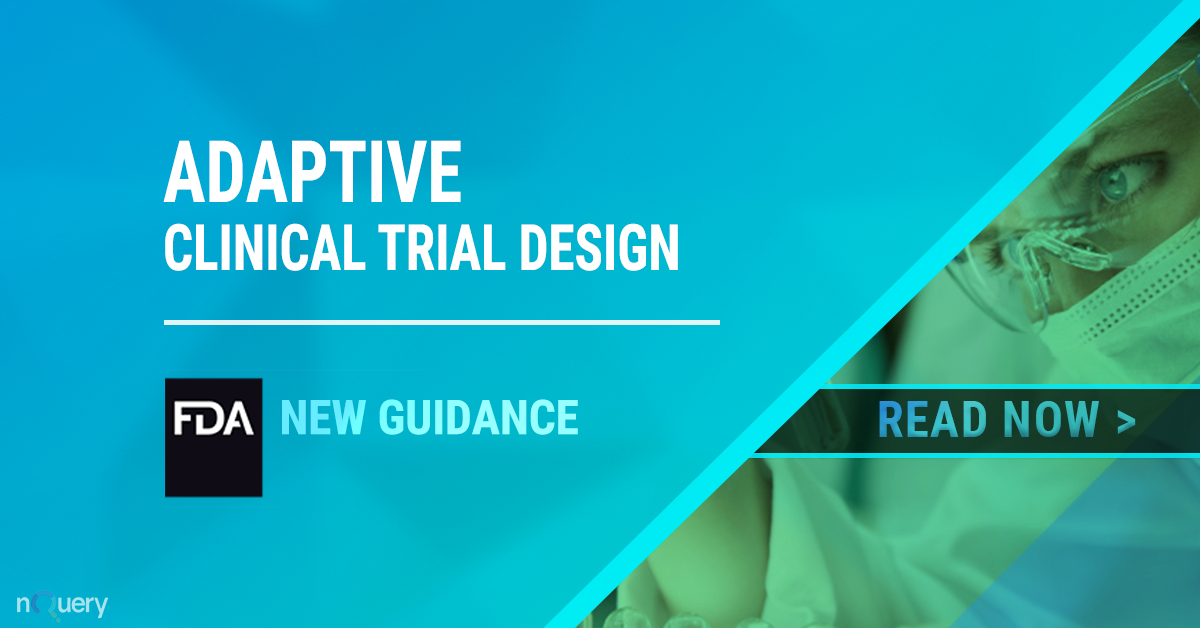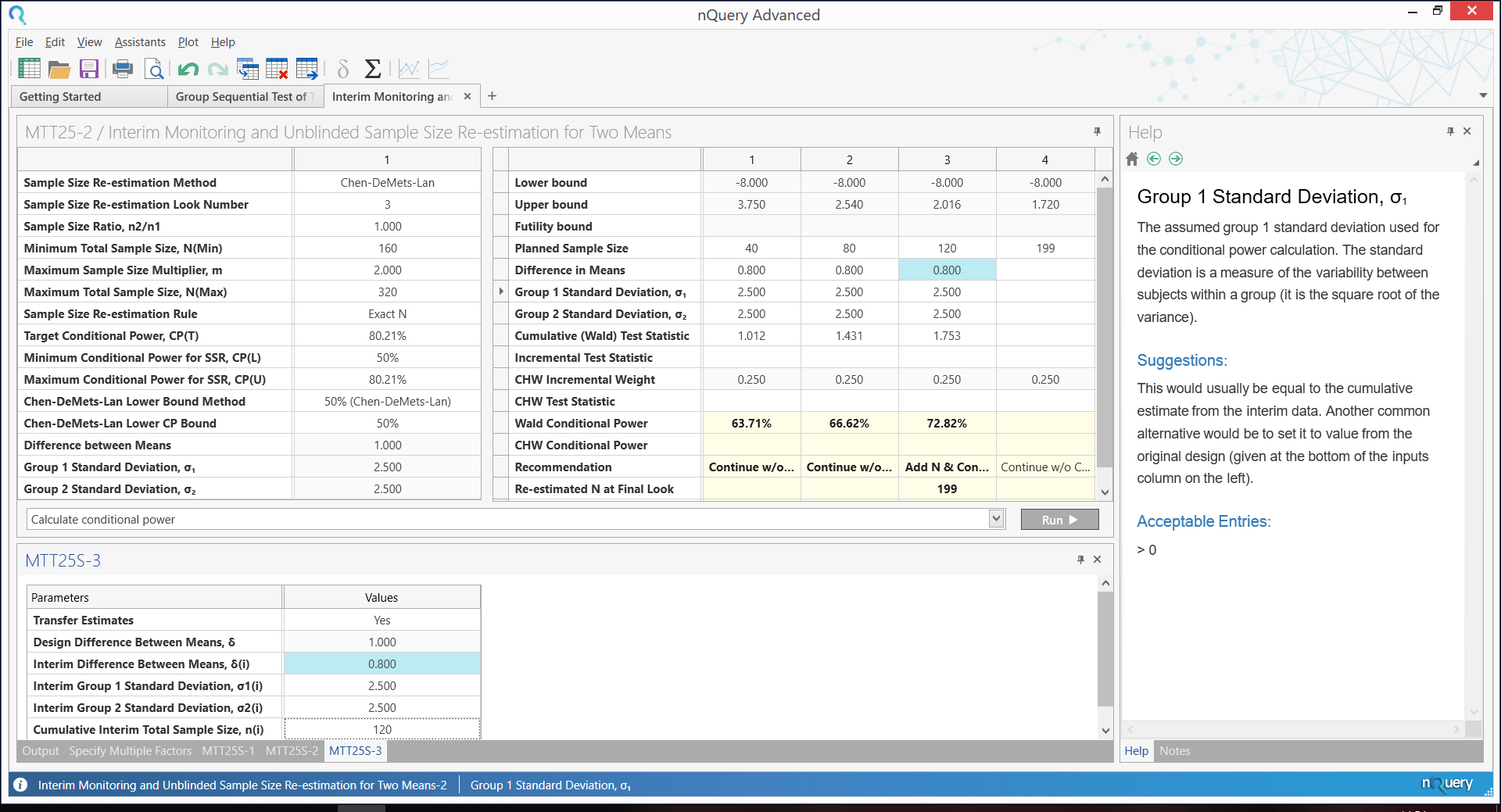Recently the FDA published the revised draft guidance on "Adaptive Designs for Clinical Trials of Drugs and Biologics". This is a quick summary of the guidance and what sample size challenges and opportunities Biostatisticians are expected to face.

Update: Jan 2020
Who is the guidance applicable to?
The purpose of the guidance is, according to FDA Commissioner Scott Gottlieb, M.D., to modernize the approach to clinical trial design in efforts to:
(1) Make clinical trials more efficient while maintaining patient safety and
(2) Increase the amount of information concerning product safety and benefits.
This makes it applicable to any sponsor involved with upcoming:
- New drug applications (NDAs),
- Investigational new drug applications (INDs),
- Biologics licensing applications (BLAs),
- Supplemental applications / post-marketing commitments or requirements
Adaptive designs have the potential to "improve ... study power and reduce the sample size and total cost" for investigational drugs, including "targeted medicines that are being put into development today”
- FDA Commissioner - Scott Gottlieb -
What is the Adaptive Designs for Clinical Trials of Drugs and Biologics Guidance for Industry?
The September 2018 release replaces the 2010 draft guidance issued by the FDA. The clinical trial landscape has changed since 2010 regards the FDA’s stance on adaptive clinical trial design.
The guidance provides examples for Biostatisticians to review where adaptive designs have been featured. Use cases include chronic heart failure, Ebola treatment, HPV vaccine, prostate cancer plus other successful cases of an adaptive design.
What is the FDA’s definition of adaptive design?
This document describes what the FDA view as the important principles for designing, conducting and reporting the results from an adaptive clinical trial. This includes Bayesian adaptive designs and complex designs relying on computer simulations.
The FDA define an adaptive design as “a clinical trial design that allows for prospectively planned modifications to one or more aspects of the design based on accumulating data from subjects in the trial.” The FDA also explains how adaptive trial designs can allow a trial to adjust to information that was not available when the trial began.
VIDEO: What is the FDA's Guidance on Adaptive clinical trials?
What are the benefits of adaptive designs for clinical trials?
The benefits of adaptive designs can be summarized as the ability to make changes to a study in progress which in turn allows investigators to take into account new information that was not known when the study began.
For sponsors, adaptive designs can potentially both save time and reduce costs. The FDA group the advantages of adaptive design into the following categories:
- Statistical efficiency
In some cases, an adaptive design can provide a greater chance to detect a true drug effect (i.e., greater statistical power) than a comparable non-adaptive design.
- Ethical considerations
Adaptive designs can provide many ethical advantages over a non-adaptive design. Such as early termination of trials once it becomes clear that a trial is unlikely to demonstrate effectiveness, thereby minimizing risk to participants. This also provides participants with the opportunity to explore more promising therapeutic alternatives.
- Advantages in generalizability and improved understanding of drug effect
An adaptive design can make it possible to answer broader questions that would not be achievable if it were a non-adaptive design.
For example, using an adaptive enrichment design may provide sponsors with the ability to demonstrate effectiveness in either a given population of patients or a targeted subgroup of that population. If this were applied to a non-adaptive design, it may require an unfeasible large sample size.
An adaptive clinical trial design may also result in an improved understanding of the effect of the experimental treatment. For example, a design with adaptive dose selection may yield better estimates of the dose-response relationship which may also lead to more efficient subsequent trials.
- Acceptability to stakeholders
Committing to a trial that allows planned design modifications based on accumulating information may be more attractive to sponsors.
Patients may favour enrolling in an adaptive design clinical trial over a traditional trial that uses response-adaptive randomization because these trials can increase the probability that subjects will be assigned to the more effective treatment.
The Winter 2018 nQuery release has an module dedicated to Sample Size Determination for Adaptive Clinical Trials. You can see more about this in our What's New in nQuery page
What are the limitations of adaptive designs for clinical trials?
While there are many benefits to adaptive designs, the draft guidance recognizes that adaptive designs require careful consideration as, like any trial, a poorly planned and operated trial can result in incorrect conclusions of safety or effectiveness.
- Preplanning adaptive design modifications can require more effort at the design stage, leading to longer lead times between planning and starting the trial.
- Gains in efficiency in some respects may be offset by losses in other respects.
- The risk of bias from early unblinding of a study.
- An increase in “Type I” (false positive) errors. To mitigate this risk of concluding a drug has a beneficial effect when it does not, the draft guidance recommends sponsors employ methods to determine appropriate statistical thresholds for interim and final analysis to ensure that the overall Type I error is controlled at 2.5 percent.
What do industry experts think of the new guidance?
An article on outsourcing-pharma.com quotes many industry experts in response to the new guidance. CRO's as well as pharmaceutical Biostatisticians are happy with the updated guidance.
“ACRO supports this benefit of adaptive design trials as a learning system, where clinical researchers can integrate new data and refine trials to be smarter and more efficient,” ...including concepts of adaptive enrichment, adaptive endpoint selection, and the use of single control arms.
- Karen Noonan, Association of Clinical Research Organizations (ACRO), VP of Global Regulatory Policy -
What should sponsors now do prior to conducting an Adaptive Trial?
Like all clinical trials, pre-specification is a core pillar to adaptive design clinical trials. The FDA state an adaptive protocol and statistical analysis plan will be more complex than that of a trial with a non-adaptive design. For an effective evaluation from the FDA, they recommend documentation be submitted to the Agency in line with the guidance E9 Statistical Principles for Clinical Trials Prior to initiation of an adaptive design.
Points to note include:
- A rationale for the selected design
- Detailed monitoring and adaptation plan
This includes the anticipated number and timing of interim analyses, the specific aspects of the design that may be modified, and the specific rule that will be used to make adaptation decisions.
- Prespecification of the planned statistical methods
What will be used to produce interim results and guide adaptation decisions, and to carry out hypothesis tests, estimate treatment effects, and estimate uncertainty in the treatment effect estimates at the end of the trial.
- Software to carry out interim and final analyses
If commercially available solutions are not available, computer code should be programmed and submitted to FDA before the trial.
What role can nQuery play in your Adaptive design clinical trials?
nQuery contains a module for sample size determination for adaptive clinical trials. The module - nQuery Adapt - provides Biostatisticians with a range of tables that spans various adaptive disciplines for sample size calculation.
How do I learn more about adaptive design clinical trials?
We recently held a webinar discussing adaptive designs. You can watch Innovative Sample Size Methods for Adaptive Clinical Trials below. Given the high failure rates and the increased costs of clinical trials, researchers need innovative design strategies to best optimize financial resources and reduce the risk to patients. Adaptive designs are emerging as a way to reduce risk and cost associated with clinical trials.
 In this webinar, we demonstrate the new nQuery adaptive module focusing on Sample Size Re-Estimation & Group-Sequential Design.
In this webinar, we demonstrate the new nQuery adaptive module focusing on Sample Size Re-Estimation & Group-Sequential Design.
In this webinar you will learn about:
- The pros and cons of adaptive designs
- Sample Size Re-Estimation
- Group-Sequential Design
- Conditional Power
- Predictive Power





















Comments (5)